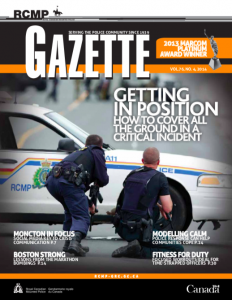Part I: Deconstructing

The original image that I selected is the front cover of a quarterly, federal gazette for Canada’s Royal Canadian Mounted Police. As per their own description, the publication’s purpose is “to provide information to partners and communities about the services of the Royal Canadian Mounted Police, and to provide readers with an understanding of the latest trends and practices within the collective Canadian law enforcement community.” I selected this cover image because I felt that it encompassed not only the message and patriarchal tone of the journal but also the hypocrisy of the journal’s content. The image of the armed officers in anticipation of violence and conflict, framed by buzzwords like “crisis communication”, “modeling calm”, etc. immediately struck me as manicured, sweeping statements that prop up the RCMP’s declared mission statements. I found these ironies troubling in light of both the RCMP’s deeply problematic history but also the present realities of colonial policing. While I acknowledge the complicated nature of a police force comprised of individuals with separate, histories and actions, the force as a collective is riddled with countless examples of unnecessary and excessive violence, exploitative abuses of power, blatant racism especially towards Indigenous peoples of Canada. My goal in manipulating this image for the Culture Jam assignment is to challenge and denaturalize our associations of justice and safety with law enforcement that is governed, controlled, and facilitated by abusive agents of the colonial project.
Part 2: Jamming

In front of the armed officers and cruiser, I photoshopped in an image of Indigenous protestors marching solidarity with Wet’suwet’en and those standing in defense of the Gidimt’en Access Point. Currently, the RCMP is enforcing a court injunction on Wet’suwet’en territory in northern B.C. that is pushing the expansion of the Coastal Gaslink pipeline. For many of us, fossil fuels and pipelines as a concept have become emblematic of capitalist environmental exploitation but we typically do not expand our critique further to examine who is implicated in the defense and support of pipeline expansion, especially when these actors are not directly employed by the gas and oil companies themselves. As I said earlier in my deconstruction of the original cover, there is a tendency to conflate law enforcement with safety and justice, when our positionality grants us the privilege of protection. This altered aspect of the image is meant to challenge this notion of safety and protection, not only in regards to the body but also the land. I also altered some of the small text like that of the award stamp, changing it to an award given by TransCanada, the company which Coastal Gaslink is the subsidiary of. I do this call attention to ways in which large corporations and government agencies do not operate in isolation from one another. Lastly, I altered the title of this issue while keeping the phrase “Getting in Position” next to the crouched RCMP officers because wanted to further subvert the imaginary of RCMP that many Candian’s hold (the red-suited, unarmed Mountie on horseback waving our flag in devotion to the true north) and center the reality of an officer holding a weapon in opposition the people marching to protect their rights against defenders of those trying to violate them.
Source Image: http://publications.gc.ca/site/eng/9.505368/publication.html
